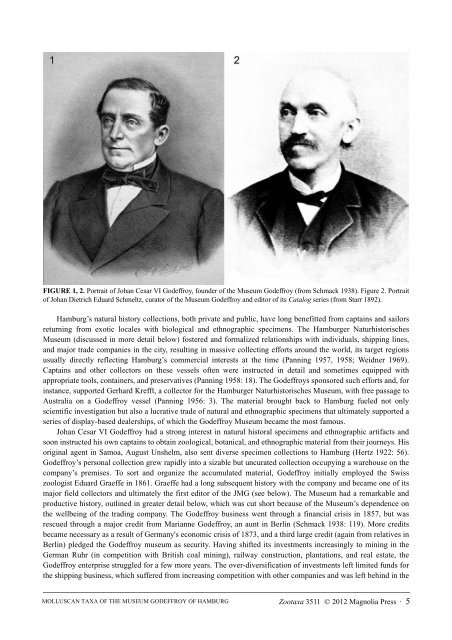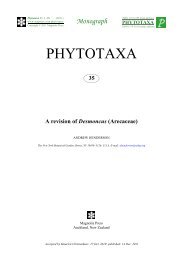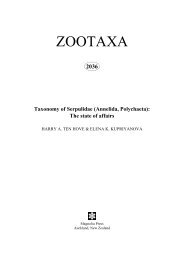You also want an ePaper? Increase the reach of your titles
YUMPU automatically turns print PDFs into web optimized ePapers that Google loves.
FIGURE 1, 2. Portrait of Johan Cesar VI Godeffroy, founder of the Museum Godeffroy (from Schmack 1938). Figure 2. Portrait<br />
of Johan Dietrich Eduard Schmeltz, curator of the Museum Godeffroy and editor of its Catalog series (from Starr 1892).<br />
Hamburg’s natural history collections, both private and public, have long benefitted from captains and sailors<br />
returning from exotic locales with biological and ethnographic specimens. The Hamburger Naturhistorisches<br />
Museum (discussed in more detail below) fostered and formalized relationships with individuals, shipping lines,<br />
and major trade companies in the city, resulting in massive collecting efforts around the world, its target regions<br />
usually directly reflecting Hamburg’s commercial interests at the time (Panning 1957, 1958; Weidner 1969).<br />
Captains and other collectors on these vessels often were instructed in detail and sometimes equipped with<br />
appropriate tools, containers, and preservatives (Panning 1958: 18). The Godeffroys sponsored such efforts and, for<br />
instance, supported Gerhard Krefft, a collector for the Hamburger Naturhistorisches Museum, with free passage to<br />
Australia on a Godeffroy vessel (Panning 1956: 3). The material brought back to Hamburg fueled not only<br />
scientific investigation but also a lucrative trade of natural and ethnographic specimens that ultimately supported a<br />
series of display-based dealerships, of which the Godeffroy Museum became the most famous.<br />
Johan Cesar VI Godeffroy had a strong interest in natural historal specimens and ethnographic artifacts and<br />
soon instructed his own captains to obtain zoological, botanical, and ethnographic material from their journeys. His<br />
original agent in Samoa, August Unshelm, also sent diverse specimen collections to Hamburg (Hertz 1922: 56).<br />
Godeffroy’s personal collection grew rapidly into a sizable but uncurated collection occupying a warehouse on the<br />
company’s premises. To sort and organize the accumulated material, Godeffroy initially employed the Swiss<br />
zoologist Eduard Graeffe in 1861. Graeffe had a long subsequent history with the company and became one of its<br />
major field collectors and ultimately the first editor of the JMG (see below). The Museum had a remarkable and<br />
productive history, outlined in greater detail below, which was cut short because of the Museum’s dependence on<br />
the wellbeing of the trading company. The Godeffroy business went through a financial crisis in 1857, but was<br />
rescued through a major credit from Marianne Godeffroy, an aunt in Berlin (Schmack 1938: 119). More credits<br />
became necessary as a result of Germany's economic crisis of 1873, and a third large credit (again from relatives in<br />
Berlin) pledged the Godeffroy museum as security. Having shifted its investments increasingly to mining in the<br />
German Ruhr (in competition with British coal mining), railway construction, plantations, and real estate, the<br />
Godeffroy enterprise struggled for a few more years. The over-diversification of investments left limited funds for<br />
the shipping business, which suffered from increasing competition with other companies and was left behind in the<br />
MOLLUSCAN TAXA OF THE MUSEUM GODEFFROY OF HAMBURG<br />
Zootaxa 3511 © 2012 <strong>Magnolia</strong> <strong>Press</strong> · 5
















